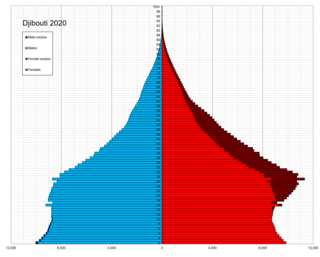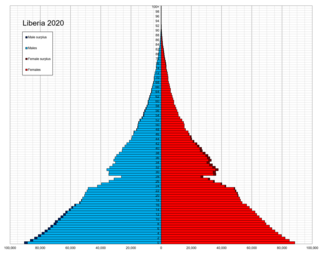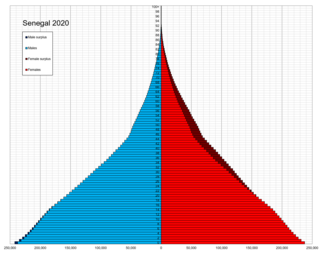| Demographics of Niger | |
|---|---|
 Population pyramid of Niger in 2020 | |
| Population | 24,484,587 (2022 est.) |
| Growth rate | 3.66% (2022 est.) |
| Birth rate | 47.08 births/1,000 population (2022 est.) |
| Death rate | 9.87 deaths/1,000 population (2022 est.) |
| Life expectancy | 60.09 years |
| • male | 58.55 years |
| • female | 61.68 years |
| Fertility rate | 6.82 children born/woman (2022 est.) |
| Infant mortality rate | 66.81 deaths/1,000 live births |
| Net migration rate | -0.64 migrant(s)/1,000 population (2022 est.) |
| Age structure | |
| 0–14 years | 50.58% |
| 65 and over | 2.68% |
| Nationality | |
| Nationality | Nigerien |
| Language | |
| Official | French |
The demographic features of Nigeriens, the people of Niger consist of population density, ethnicity, education level, health of the populace, economic status, religious affiliations and other aspects of the population.
Contents
- Population
- Census results
- UN estimates
- Vital statistics
- Fertility and births
- Ethnic groups
- Core health indicators
- Other demographic statistics
- Population 2
- Religions
- Age structure
- Birth rate
- Death rate
- Total fertility rate
- Median age
- Population growth rate
- Mother's mean age at first birth
- Contraceptive prevalence rate
- Net migration rate
- Dependency ratios
- Urbanization
- Sex ratio
- Life expectancy at birth
- Major infectious diseases
- Education expenditures
- Literacy
- Nationality
- Ethnic groups 2
- Languages
- School life expectancy (primary to tertiary education)
- Youth unemployment (ages 15-24)
- See also
- References
The largest ethnic groups in Niger are the Hausa, who also constitute the major ethnic group in northern Nigeria, and the Zarma-Songhai (also spelled Djerma-Songhai), who also are found in parts of Mali. Both groups are sedentary farmers who live in the arable, southern tier. The Kanouri (including Beri Beri, Manga) make up the majority of sedentary population in the far southeast of the nation. The remainder of the Nigerien people are nomadic or seminomadic livestock-raising peoples—Tuareg, Fulani, [1] Toubou and Diffa Arabs. With rapidly growing populations and the consequent competition for meager natural resources, lifestyles of these two types of peoples have come increasingly into conflict in Niger in recent years. Some white French people live in the country due to Niger being a former colony of France.
Niger's high infant mortality rate is comparable to levels recorded in neighboring countries. However, the child mortality rate (deaths among children between the ages of 1 and 4) is exceptionally high (274 per 1,000) due to generally poor health conditions and inadequate nutrition for most of the country's children. Niger's very high total fertility rate (6.89 children born per woman, which is the highest in the world [2] ), nonetheless, means that nearly half (49%) of the Nigerien population is under age 15. School attendance is low (34%), including 38% of males and 27% of females. Additional education occurs through Koranic schools.























